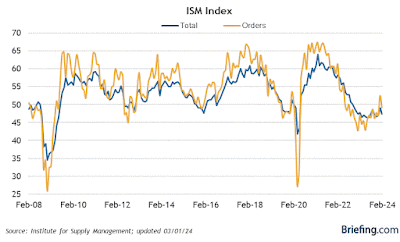Manufacturing and construction show softness to start the month
– by New Deal democrat
As usual, the new month’s data starts out with information on manufacturing and construction.
The ISM manufacturing index has been a good leading indicator in that sector for 75 years. The difference over time, especially the last 20 years, is that manufacturing makes up a smaller share of the total US economy. As a result, even though it has almost consistently been in contraction ever since late 2022, to levels that before 2000 would always have meant recession, that didn’t happen in 2023.
In January, the total index rose to near its equipoise point of 50, and for the first time all year, the more leading new orders index surpassed that level. In February, the two retrenched, as the total index declined to 47.8, and the new orders index declined to 49.2:
Although this indicates softening, on the other hand neither of these is nearly as bad is their low levels last year. In terms of the economy as a whole, count this as a neutral.
After a string of reports indicating strong improvement, both total construction spending and the more leading residential construction spending declined -0.2% in January from their all time nominal highs:
This decline is amplified in real terms by the fact that producer prices for construction materials (red) rose a full 2.0% (note: graph normed to 100 as of December 2022 for better clarity):
This is the first negative construction spending report since last May.
In sum, both leading sectors showed softness in these reports, but not enough to suggest any significant change of trend to a downturn at this point.
“New month’s data starts out with leading indicators in both manufacturing and construction indicating expansion,” Angry Bear, by New Deal democrat






